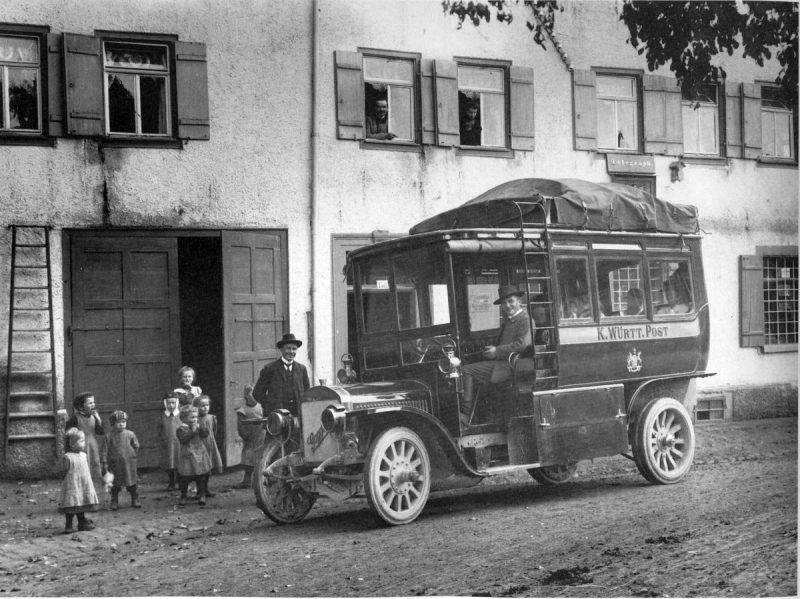Long-distance bus transport in Germany has undergone a remarkable transformation in recent decades, characterized by a long history, regulations and ultimately the dominance of a single provider. In order to understand this development, it is also necessary to take a look at the beginnings of long-distance bus transport in Germany, the former motor mail lines, and follow the liberalization until the emergence of a de facto monopoly.
Long-distance buses have now become an integral part of Germany. They are considered an inexpensive alternative to trains, which are often perceived as expensive and unpunctual. Immediately after liberalization, various entrepreneurs, including “big fish,” saw big money. Even Deutsche Post tried to make a comeback in passenger transport. Ultimately, however, the Flixbus company developed a defacto monopoly.
The roots of long-distance bus transport: the Kraftpost lines
Long-distance bus transport in Germany has historical roots that go back to the time of the Weimar Republic. In the 1920s and 1930s, a dense network of power postal lines developed, connecting not only cities but also remote regions. These lines were operated by the Reichspost and already back then used a road network that also ran along Reichsautobahns and federal highways. The Kraftpost lines were an important part of public transport in Germany.
It should also be noted that when the Reich motorways were built, the Kraftpost long-distance bus routes were taken into account or were newly added. There were stops directly on the motorways on many routes. This is unimaginable today for safety reasons, but back then the volume of traffic was not significant and any fencing or guard rails did not even exist. Small paths led to the Kraftpost stops on the Reich motorways, most of which were completed on foot.
The Kraftpost long-distance bus lines were initially very important because many places could not be reached by rail or only took a considerably longer time. Added to this is the fact that the Nazi regime placed the Reichsautobahnen GmbH under the organizational control of the Deutsche Reichsbahn. The railway was therefore indirectly responsible for the management of the high-ranking roads and it was therefore obvious that passenger transport should also be set up. Due to the legal situation at the time, the commercial transport of passengers by bus, which did not take place parallel to railway lines, was not the responsibility of the Reichsbahn, but rather the Reichspost, which referred to its buses as Kraftpost at the time.
The closure of the Kraftpost lines and the protection of the Deutsche Bahn
With the end of World War II, many of these power postal lines were discontinued. An important historical fact was the division of Germany and the creation of West Berlin. In order to connect West Berlin with the rest of the Federal Republic, long-distance bus lines were set up, but these could only offer limited national connections. This was a measure to protect Deutsche Bahn, which, as a state-owned company, had a monopoly position.
The reasons for the discontinuation of the Kraftpost long-distance lines were not exclusively due to the protection of Deutsche Bahn. The Deutsche Bundespost had no interest in giving up this business area because it was still active in public transport. The main reason is that transport has become economically unsustainable, because due to the fact that politics pushed the motorization of the population, it was considered an expression of poverty to use public transport. Due to a lack of demand, the Kraftpost lines were no longer viable and were gradually discontinued. This means that the last bus stops that were built on what are now federal highways under the Nazi regime have been dismantled. Regardless, this would have happened sooner or later for safety reasons alone. Towards the end of the Kraftpost express connections, these were briefly referred to as “postal travel services”.
West Berlin was a special case. Due to the lack of rail connections, concessions for long-distance bus routes were awarded to various private companies and subsidiaries of the German Federal Railways. In this way, West Berlin was connected to numerous cities in the Federal Republic of Germany. This was the usual means of transport for many years due to the fact that rail transport across the territory of the GDR was more complicated than bus transport. This resulted in the “Berlin Linien Bus” brand, which was finally discontinued by Deutsche Bahn AG a few years ago because its competitor Flixbus had prevailed in free competition. Incidentally, the once leading international long-distance bus provider (association) Eurolines also has a similar fate, as it is now only a shadow of its former self and most members now operate under the Flixbus brand or no longer exist at all.
There were also domestic flight connections to West Berlin, but these were significantly more expensive than buses. The special feature was that due to the four-power status, not Lufthansa or other providers were allowed to fly with German AOCs, but only those from the victorious powers. Several US, French and British airlines had stationed aircraft in Germany for Berlin traffic. This regulation applied to the inner-city airports Tegel and Tempelhof, as they were located in the urban area of West Berlin. These restrictions did not apply to Schönefeld because the GDR capital airport was located outside the city limits of Berlin.

On board a BlaBlaCar long-distance bus (Photo: Jan Gruber). 
Long-distance bus (Photo: BlaBlaCar Bus). 
Long-distance bus (Photo: BlaBlaCar Bus). 
Long-distance bus (Photo: BlaBlaCar Bus). 
Long-distance bus (Photo: BlaBlaCar Bus). 
Long-distance bus (Photo: BlaBlaCar Bus). 
Long-distance bus (Photo: BlaBlaCar Bus). 
Long-distance bus (Photo: BlaBlaCar Bus). 
Long-distance bus (Photo: BlaBlaCar Bus). 
Bus on a bridge (Photo: BlaBlaCar Bus). 
Bus on a bridge (Photo: BlaBlaCar Bus). 
Pinkbus (Photo: Robert Spohr). 
Pinkbus (Photo: Robert Spohr). 
Pinkbus (Photo: Pinkbus). 
Pinkbus (Photo: Pinkbus). 
Flixbus and Pinkbus (Photo: Robert Spohr).
The liberalization of long-distance bus transport and the first providers
The actual liberalization of long-distance bus transport in Germany only began in the 2010s. In 2013, the Passenger Transport Act was changed to facilitate market access for private bus companies. This marked the beginning of a new era for German long-distance bus transport.
Immediately after liberalization, various providers entered the market. The pioneers included companies such as MeinFernbus and Postbus. Soon afterwards, another name came onto the scene that would change the German long-distance bus landscape forever: Flixbus. The Flixbus brand advertised low prices and a wide route network and quickly captured market share.
The dominance of Flixbus
Flixbus was able to further expand its dominance in the German long-distance bus market by taking over or integrating several other providers into partnerships. This led to a de facto monopoly for Flixbus, as the company controlled a large proportion of long-distance bus connections in Germany. This monopoly was symbolized by the visible green Flixbus fleet on German highways.
Large corporations such as National Express, the Austrian Federal Railways, ADAC, Deutsche Post, Deutsche Bahn and many others that had tried it either gave up or sold their long-distance bus business to competitor Flixbus.
Notable competitors are: French BlablaCar bus, Czech provider Regiojet as well as the last remaining international Eurolines routes. The number of the latter was once again decimated due to the fact that the former Bahn subsidiary Deutsche Touring, which now has Croatian owners, switched to Flixbus.
The examples of Roadjet and Pinkbus show how difficult it is to successfully set up new long-distance bus offers in competition with Flixbus. Both companies failed to compete economically with FlixMobility and the routes have now had to be discontinued. Interestingly, both providers are now looking for their fortune in the charter business, which is already subject to fierce competition and Flixbus is also very strong in brokerage here.

On board a Flixbus (Photo: Robert Spohr). 
broken folding table (photo: Robert Spohr). 
Interior of the Iveco Flixbus (Photo: Robert Spohr). 
Interior of the Iveco Flixbus (Photo: Robert Spohr). 
Seats in the Iveco Flixbus (Photo: Robert Spohr). 
Flixbus (Photo: Robert Spohr). 
Flixbus in Munich (Photo: Jan Gruber). 
Seats in the Flixbus double-decker (Photo: Jan Gruber). 
Seats in the Flixbus double-decker (Photo: Jan Gruber). 
Flixbus in Munich (Photo: Jan Gruber). 
Flixbus (Photo: Jan Gruber). 
Flixbus (Photo: Jan Gruber). 
Flixbus (Photo: Jan Gruber). 
Flixbus at Stuttgart Airport (Photo: Stuttgart Airport). 
Flixbus double-decker bus (Photo: Jan Gruber).
The situation in Austria and Switzerland
In Austria and Switzerland, the long-distance bus market for domestic transport has not yet been able to develop to the same extent as in Germany. This is partly due to the well-established and connected railway systems in both countries, which represent strong competition. In addition, the markets have not been liberalized in the same way as in Germany, which has hindered the emergence of a flourishing long-distance bus market.
Another reason for this is that the legal situation in both Switzerland and Austria requires complicated approval procedures for new long-distance bus routes. Top dogs such as ÖBB or SBB as well as Postbus and Postauto are also involved in this and have a kind of say.
The introduction of the climate ticket in Austria and the fact that the national long-distance bus routes operated by Blaguss Reisen and Dr. Richard, which is offered under the Flixbus brand, was excluded from the network map by the Ministry of Transport, has shown its effects. For economic reasons, Blaguss had to give up the domestic routes from Vienna to Klagenfurt and from Graz to Salzburg and Linz. Passenger numbers and therefore revenues have collapsed. Dr. Richard continues to serve Vienna-Graz and Graz-Vienna Airport. The last-mentioned route is considered an important feeder route from Styria and southern Burgenland to Austria's largest airport.
A special feature is the long-distance bus line between Graz and Klagenfurt. This is served by Österreichische Postbus AG, whereby the ÖBB rail tariff applies. Formally, this is a permanent rail replacement service, which is why the climate ticket also applies. However, the opening of the Koralm Tunnel will mean that this connection will most likely become history.
Long-distance buses got the German public transport market moving
German long-distance bus transport has an eventful history, ranging from the former Kraftpost lines to the protection of Deutsche Bahn to liberalization and the dominance of Flixbus. Despite Flixbus's de facto monopoly, there is still some diversity in the market and the future of this transport sector remains exciting, especially in light of growing sustainability requirements and changes in mobility.
In Austria and Switzerland, on the other hand, the chances of a long-distance bus boom in domestic transport are initially rather poor, as traditional means of transport continue to dominate and liberalization has so far failed to materialize. This is primarily a political decision. In Austria, the incumbent Transport Minister Leonore Gewessler (Greens) is pushing night train connections and subsidizing them with millions. On the other hand, not only do people not attach any importance to bus and air transport, they also put “stones” in their way. In the case of long-distance buses, this is precisely because they are excluded from the climate ticket under the pretext that there are alternatives by rail.













 trail (for them it's free to use)
trail (for them it's free to use)